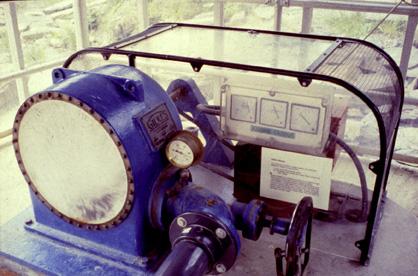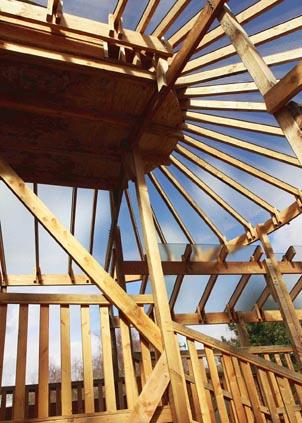Difference between revisions of "CAT Wales"
| Line 1: | Line 1: | ||
| − | |||
This Centre for Alternative Technology aims to show people how to live in a sustainable manner, in rural as well as in fully developed, urban areas. The centre focuses on renewable energy, environmental building, energy efficiency, organic growing and alternative sewage systems. The centre has a range of interactive displays and other exhibits of sustainable technologies in these fields. | This Centre for Alternative Technology aims to show people how to live in a sustainable manner, in rural as well as in fully developed, urban areas. The centre focuses on renewable energy, environmental building, energy efficiency, organic growing and alternative sewage systems. The centre has a range of interactive displays and other exhibits of sustainable technologies in these fields. | ||
| Line 8: | Line 7: | ||
==Technology Exhibits:== | ==Technology Exhibits:== | ||
| − | ====Water management==== | + | ====Water management==== |
| − | [[Image: | + | [[Image:hydroturbine.jpg|thumb|right|150px|Hydroturbine at the water management display]] |
Water is supplied to the centre through rainwater harvested in reservoirs. Some of this is used directly, for example to flush toilets or water the gardens. For drinking water however, the water is treated through a slow sand filter and a UV filter. They also try and conserve water around the centre, using low flush toilets or waterless urinals, water saving taps, etc. Further shown, is how the water cycle can be used to generate electricity. For example, turbines are installed where the water flows downhill. | Water is supplied to the centre through rainwater harvested in reservoirs. Some of this is used directly, for example to flush toilets or water the gardens. For drinking water however, the water is treated through a slow sand filter and a UV filter. They also try and conserve water around the centre, using low flush toilets or waterless urinals, water saving taps, etc. Further shown, is how the water cycle can be used to generate electricity. For example, turbines are installed where the water flows downhill. | ||
====Construction methods==== | ====Construction methods==== | ||
| − | [[Image: | + | [[Image:Eco-building.jpg|thumb|right|150px|Timber frames and glass roof of a soon to be eco friendly building]] |
The centre displays various buildings which are low-impact in different ways. Some for example are built using turf roofs, biodegradable materials or solar panels. They are also energy efficient, and use for example passive solar heating, where sunlight coming in through big windows warms the room. | The centre displays various buildings which are low-impact in different ways. Some for example are built using turf roofs, biodegradable materials or solar panels. They are also energy efficient, and use for example passive solar heating, where sunlight coming in through big windows warms the room. | ||
====Composting==== | ====Composting==== | ||
| − | [[Image: | + | [[Image:compost heap.jpg|thumb|right|150px|A new compost heap]] |
Since the centre is built on an unused slate quarry, compost was much needed to rebuild the soil. They have a large interactive display explaining how it works. They recently installed a composter, which runs on renewable energy. Further they employ a compost toilet at the centre, which directly converts sanitation products into compost. | Since the centre is built on an unused slate quarry, compost was much needed to rebuild the soil. They have a large interactive display explaining how it works. They recently installed a composter, which runs on renewable energy. Further they employ a compost toilet at the centre, which directly converts sanitation products into compost. | ||
====Organic gardening==== | ====Organic gardening==== | ||
| − | [[Image: | + | [[Image:garden.jpg|thumb|right|150px|Visitors looking at food crops in one of the gardens]] |
There are various different gardens, where crops are grown which are used for food around the centre. They also display how compost was used to convert the slate and dust into fertile gardens. There is also a woodland area, where various types of trees are grown and used to build furniture in a sustainable manner. | There are various different gardens, where crops are grown which are used for food around the centre. They also display how compost was used to convert the slate and dust into fertile gardens. There is also a woodland area, where various types of trees are grown and used to build furniture in a sustainable manner. | ||
====Solar energy==== | ====Solar energy==== | ||
| − | [[Image: | + | [[Image:solar phonebox.jpg|thumb|right|150px|Family using solar powered phonebooth]] |
There is a range of solar panels, photovoltaic devices, a solar water heating system and passive solar heating (for buildings). | There is a range of solar panels, photovoltaic devices, a solar water heating system and passive solar heating (for buildings). | ||
| Line 32: | Line 31: | ||
====Whole Home==== | ====Whole Home==== | ||
| − | [[Image: | + | [[Image:eco-home.jpg|thumb|right|150px|one of the whole homes exhibited]] |
| − | The eco-friendly | + | The eco-friendly houses show easy methods of making your home more sustainable. One of the buildings is known as the best insulated building in Britain. It is filled with environmentally friendly household appliances. The garden outside, shows how rainwater can be harvested, food can be grown, composting, and other purposes. |
====Wind Power==== | ====Wind Power==== | ||
| − | [[Image: | + | [[Image:wind pavilion.jpg|thumb|right|150px|The wind pavilion]] |
There are a range of wind turbines in the CAT’s wind pavilion, each with a different capacity. Ranging from those suitable to charge vehicle batteries to those used to power hundreds of homes. Many of the appliances in the eco-cabins at the centre, run on energy from their wind generator. The CAT’s initiative also encouraged the building of two large turbines outside the centre, used by the community surrounding. | There are a range of wind turbines in the CAT’s wind pavilion, each with a different capacity. Ranging from those suitable to charge vehicle batteries to those used to power hundreds of homes. Many of the appliances in the eco-cabins at the centre, run on energy from their wind generator. The CAT’s initiative also encouraged the building of two large turbines outside the centre, used by the community surrounding. | ||
Revision as of 12:04, 15 September 2010
This Centre for Alternative Technology aims to show people how to live in a sustainable manner, in rural as well as in fully developed, urban areas. The centre focuses on renewable energy, environmental building, energy efficiency, organic growing and alternative sewage systems. The centre has a range of interactive displays and other exhibits of sustainable technologies in these fields.
CAT is used for day visits by individuals or groups such as schools. They also run educational programmes ranging from one week upto a year long for people who want to learn more about sustainable development and other topics. They also publish books on these topics for example recently published: “Choosing Solar Electricity: a guide to photovoltaic systems”
Throughout the year they organize activities, tours, as well as other events for visitors. They also run an information centre, which people can consult for free advice on sustainable living and a consultancy service for business or bigger projects.
Contents
Technology Exhibits:
Water management
Water is supplied to the centre through rainwater harvested in reservoirs. Some of this is used directly, for example to flush toilets or water the gardens. For drinking water however, the water is treated through a slow sand filter and a UV filter. They also try and conserve water around the centre, using low flush toilets or waterless urinals, water saving taps, etc. Further shown, is how the water cycle can be used to generate electricity. For example, turbines are installed where the water flows downhill.
Construction methods
The centre displays various buildings which are low-impact in different ways. Some for example are built using turf roofs, biodegradable materials or solar panels. They are also energy efficient, and use for example passive solar heating, where sunlight coming in through big windows warms the room.
Composting
Since the centre is built on an unused slate quarry, compost was much needed to rebuild the soil. They have a large interactive display explaining how it works. They recently installed a composter, which runs on renewable energy. Further they employ a compost toilet at the centre, which directly converts sanitation products into compost.
Organic gardening
There are various different gardens, where crops are grown which are used for food around the centre. They also display how compost was used to convert the slate and dust into fertile gardens. There is also a woodland area, where various types of trees are grown and used to build furniture in a sustainable manner.
Solar energy
There is a range of solar panels, photovoltaic devices, a solar water heating system and passive solar heating (for buildings).
Transport
Travelling from place to place within the centre, also shows how transportation can be made sustainable. For example, there is a water balanced cliff railway. A train takes people up and down the hill, using water as a counterweight.
Whole Home
The eco-friendly houses show easy methods of making your home more sustainable. One of the buildings is known as the best insulated building in Britain. It is filled with environmentally friendly household appliances. The garden outside, shows how rainwater can be harvested, food can be grown, composting, and other purposes.
Wind Power
There are a range of wind turbines in the CAT’s wind pavilion, each with a different capacity. Ranging from those suitable to charge vehicle batteries to those used to power hundreds of homes. Many of the appliances in the eco-cabins at the centre, run on energy from their wind generator. The CAT’s initiative also encouraged the building of two large turbines outside the centre, used by the community surrounding.





